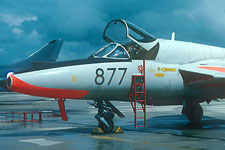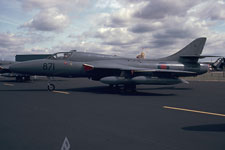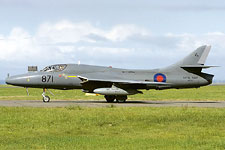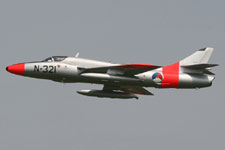| XF357's service history
Hawker Hunter XF357 began its life as a single seat F.4, built by Hawker Aircraft (Blackpool) Ltd for the Royal Air Force.
It was delivered to the RAF on 1st March 1956, to 33MU (Maintenance Unit) at RAF Lyneham and was prepared for its military service, which began at RAF Bruggen with RAF 130(F) Sqn. XF357 remained with the Unit for its entire RAF career, which lasted until 1959 when it was transferred to the Royal Navy.
Converted to T.8 specification by Armstrong Whitworth at Coventry, XF357 was handed over to the Fleet Air Arm on 2nd June 1959. A brief period with 803NAS (Navy Air Squadron) was followed by an assignment to 764NAS at RNAS Lossiemouth in October 1960 as '696'.
Two years later it became '694', but it was soon moved onto the strength of 738NAS, also based at Lossiemouth on 18th July 1962, where it adopted the fleet number '634' and shore code 'LM' on the tail. Two days later, the aeroplane suffered an engine flameout during a routine sortie, and lost a wheel on landing a few weeks later. Its luck didn't improve the following year as it suffered a bird-strike at 100ft above the runway! During July 1963, XF357 was transferred to 759NAS at RNAS Brawdy, becoming aeroplane '656' with a 'BY' shore code, and remained with them until it was moved back to 738NAS (which was then also at Brawdy) in June 1966. In February 1970, the aeroplane underwent a major modernisation programme at RAF Kemble, thus beginning a lengthy spell on the ground.
On 8th December 1971, XF357 was assigned to Airwork's Air Direction Training Unit (ADTU) based at RNAS Yeovilton, adopting the fleet number '740'. Ferried to RNAS Lee-on-Solent in June 1972 for the fitment of a Harley light, the aeroplane was returned to service the following month. On 1st December XF357 became a part of the Fleet Requirements and Air Direction Training Unit (FRADTU), a Unit formed following the merger of the ADTU and the Fleet Requirements Unit (FRU). During the following year, the aeroplane was re-assigned the fleet number '870' and remained in service until September 1977, when it was moved to Sydenham for modernisation.
Five months later on 11th February 1978, XF357 was returned to Yeovilton as aeroplane '877', an identity it kept for the next six years.
It remained in use, aside from two short spells either under maintenance or receiving a refinish at Kemble until April 1984, when it was ferried to RAF Abingdon for an overhaul. This process took eighteen months to complete, and on its return to Yeovilton XF357 took on its fourth and final FRADU identity - '871' on 19th December 1985.
A steady period of service followed and XF357 was retired from the FRADU fleet on 16th May 1995, and was ferried to RAF Shawbury for storage and subsequent disposal. |

[© Mike Hall]

[© Mick Freer]

[© Hans Rolink]
|
XF357's civilian life
Sold into private hands at auction in July 1995, XF357 was purchased by Barry Pover and it joined the Classic Jet Aircraft Company based at
Exeter Airport arriving in February 1996. An active participant on the UK airshow circuit between 1996-97, it was sold in 1998 to Jet Heritage Ltd, based at Bournemouth Airport. It ferried down to its new home by Keith Hartley, where it was paint stripped and taken apart in preparation for a major overhaul. Midway through
this process, the owner put the aircraft up for sale and the Old Flying Machine Company acquired it. The Classic Jet Aircraft Company completed the work
on its behalf, and XF357 was re-finished into an overall-silver colour scheme on completion, representing the prototype Hunter T.7 XJ615. The Duxford-based team flew it regularly until the aeroplane changed hands again, this time to Elvington Events Ltd based in Yorkshire. The aeroplane spent much of its time based at either RAF Cranwell, RAF Leeming or Exeter during this time period.
Early in 2007, the Stichting Hawker Hunter Foundation, based in the Netherlands, acquired the aeroplane. Hunter Flying Ltd was employed to apply full Netherlands Air Force markings, which was undertaken by Ray Jeffery. With XF357 having a strong Royal Air Force and Fleet Air Arm pedigree, permission to use and wear the spurious Dutch serial N-321 was sought and granted.
On Tuesday May 15th 2007, 'N-321' was officially handed over to the Stichting Hawker Hunter Foundation (DHHF) at Exeter, and the aeroplane departed bound
for Leeuwarden airbase in the Netherlands at 1400hrs local time. The aeroplane will return to the UK periodically for maintenance, but it is hoped that it will appear at some UK-events in the future
Unfortunately, during June 2008 the aeroplane suffered a bird-strike which caused the aeroplane to be grounded temporarily, but repairs were soon completed and XF357 continued to represent Dutch Air Force Hunter operations alongside ex-RAF F.6A airframe XF515 (G-KAXF). Following the Shoreham airshow disaster in August 2015, and the subsequent restrictions placed on operating Hawker Hunter airframes fitted with the Avon 122 engine, XF357's permit to fly lapsed in May 2016.
It's long term future as a flying example it would appear is now over, as the DHHF acquired ex-Swiss Hunter T-68 J-4205 in December 2020 to replace G-BWGL. This decision was made "due to unsurmountable technical issues, it (BWGL) can longer be operated." The airframe will instead be kept in ground running condition.
- January 2021
Links
- Dutch Hawker Hunter Foundation:


|

[© Mick Freer]

[© Karl Drage]
|
